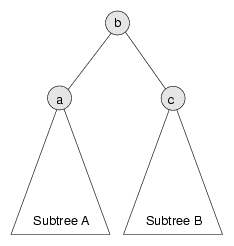| The C++Course provides a general introduction to programming in C++. It is based on A.B. Downey's book, How to Think Like a Computer Scientist. Click here for details. |

|

Home  Heap Heap  Heap Remove Heap Remove |
||






|
||
Heap Remove
It might seem odd that we are going to remove things from the heap before we insert any, but I think removal is easier to explain. At first glance, we might think that removing an item from the heap is a constant time operation, since the item with the highest priority is always at the root. The problem is that once we remove the root node, we are left with something that is no longer a heap. Before we can return the result, we have to restore the heap property. We call this operation reheapify. The situation is shown in the following figure:
The root node has priority r and two subtrees, A and B. The value at the root of Subtree A is a and the value at the root of Subtree B is b.
Once we remove r, we have to make the resulting tree a heap again. In other words we need to make sure it has the properties of completeness and heapness. The best way to ensure completeness is to remove the bottom-most, right-most node, which we'll call c and put its value at the root. In a general tree implementation, we would have to traverse the tree to find this node, but in the array implementation, we can find it in constant time because it is always the last (non-null) element of the array. Of course, the chances are that the last value is not the highest, so putting it at the root breaks the heapness property. Fortunately it is easy to restore. We know that the largest value in the heap is either a or b. Therefore we can select whichever is larger and swap it with the value at the root. Arbitrarily, let's say that b is larger. Since we know it is the highest value left in the heap, we can put it at the root and put c at the top of Subtree B. Now the situation looks like this:
Again, c is the value we copied from the last entry in the array and b is the highest value left in the heap. Since we haven't changed Subtree A at all, we know that it is still a heap. The only problem is that we don't know if Subtree B is a heap, since we just stuck a (probably low) value at its root. Wouldn't it be nice if we had a method that could reheapify Subtree B? Wait... we do!
|
||
Home  Heap Heap  Heap Remove Heap Remove |
||
Last Update: 2005-12-05



